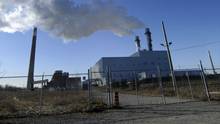Canada reaches mid-point in meeting 2020 emissions goal
 Canada is halfway toward meeting its 2020 target for reducing greenhouse gas emissions, despite projections for major increases from growing oil-sands production.
Canada is halfway toward meeting its 2020 target for reducing greenhouse gas emissions, despite projections for major increases from growing oil-sands production.Environment Minister Peter Kent announced Wednesday that combined federal and provincial actions to date will result in an emissions reduction of 130 megatonnes by 2020. Further efforts will be needed to cut emissions by an additional 113 megatonnes.
The Harper government has committed Canada to reducing greenhouse gas emissions (GHGs) by 17 per cent below 2005 levels by 2020, a target that is in line with the target adopted by U.S. President Barack Obama.
“The Harper government has been working hard to reduce emissions, and this has helped set the stage for the progress we’ve achieved this year,” Mr. Kent said.
But critics say Ottawa hasn’t gone far enough. Dr. Christian Holz, Executive Director of Climate Action Network Canada, released a statement on Wednesday criticizing the Harper government for being a ‘lobby arm’ for the oil sands.
“It is important to recognize the effect of adjusted accounting rules this year, which make it appear that we are further along that we actually are. (The “baseline” or goalpost has been changed giving the impression of better numbers without any actual meaningful policy improvements),” the statement said.
The oil industry remains by far the largest source of expected emissions growth. Between 2005 and 2020, the sector’s annual GHG output will grow by 45 megatonnes, as a result of growth in oil-sands production. That increase would completely offset the 41-megatonne reduction expected from the electricity sector.
The government is expected to soon release final regulations for the power sector which would dramatically reduce coal use. But the impact of those regulations will primarily occur after 2020, when current plants reach the end of their commercial life.
The government is promising to eventually introduce emission regulations for other sectors, including oil and gas and heavy industry, and those measures would reduce the forecasted emissions growth.
Last year, Ottawa said it was only a quarter of the way to its target. The major difference this year comes from the inclusion for the first time of land-use practices that are governed by a United Nations agreement.
As well, the federal government has introduced new fuel efficiency vehicle standards, while several provinces have unveiled new policies to cut emissions.
You can return to the main Market News page, or press the Back button on your browser.

